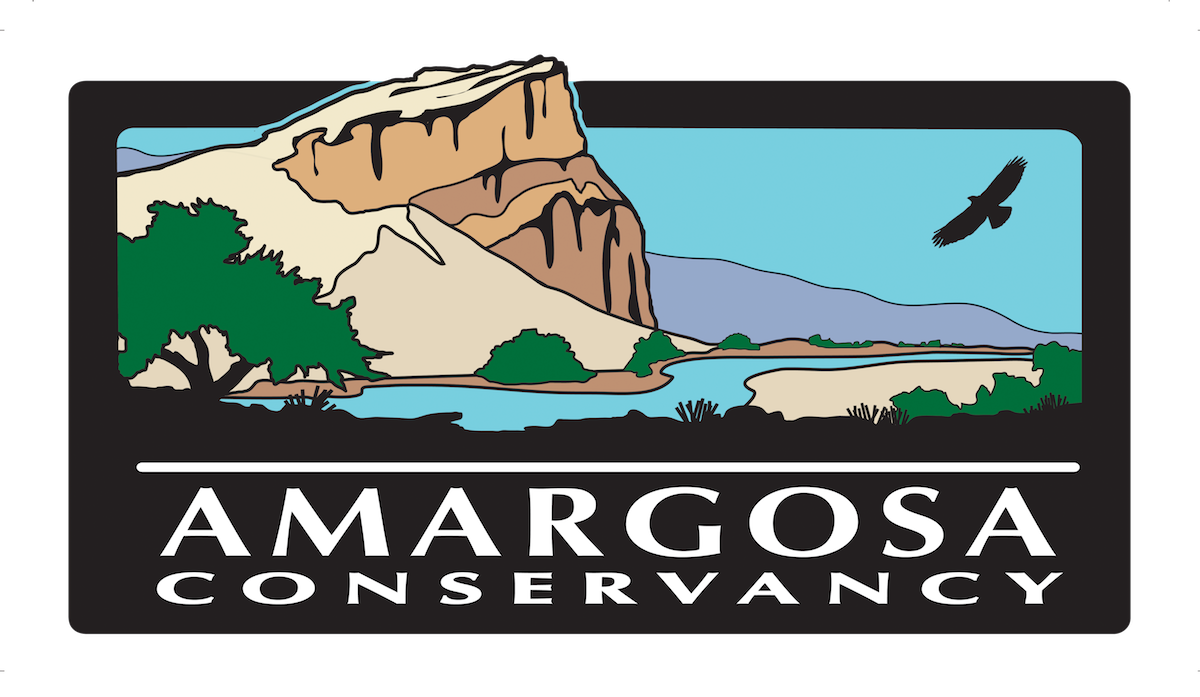By Morrigan DeVito, Restoration & Plant Stewardship Coordinator
86 degrees– despite our sweat, the botany team and I consider this to be cool weather since we’re only just starting the spring/summer field season of botanical monitoring. I joined AC board member Naomi Fraga and two of her graduate students from the California Botanic Garden at the end of April to scout for rare alkaline wetland plants and sites for future seed collections in the Amargosa River Basin, our first step in delivering on our California Wildlife Conservation Board Implementation Grant to monitor and protect these species. My personal goal was to learn to see the landscape as a botanist, to notice how the plants of the Amargosa River Basin express themselves and what they can tell us about the land. As Naomi said, to study these plants, you have to love the heat. As it turns out, by late-April, many plants had not emerged. It wasn’t hot enough.
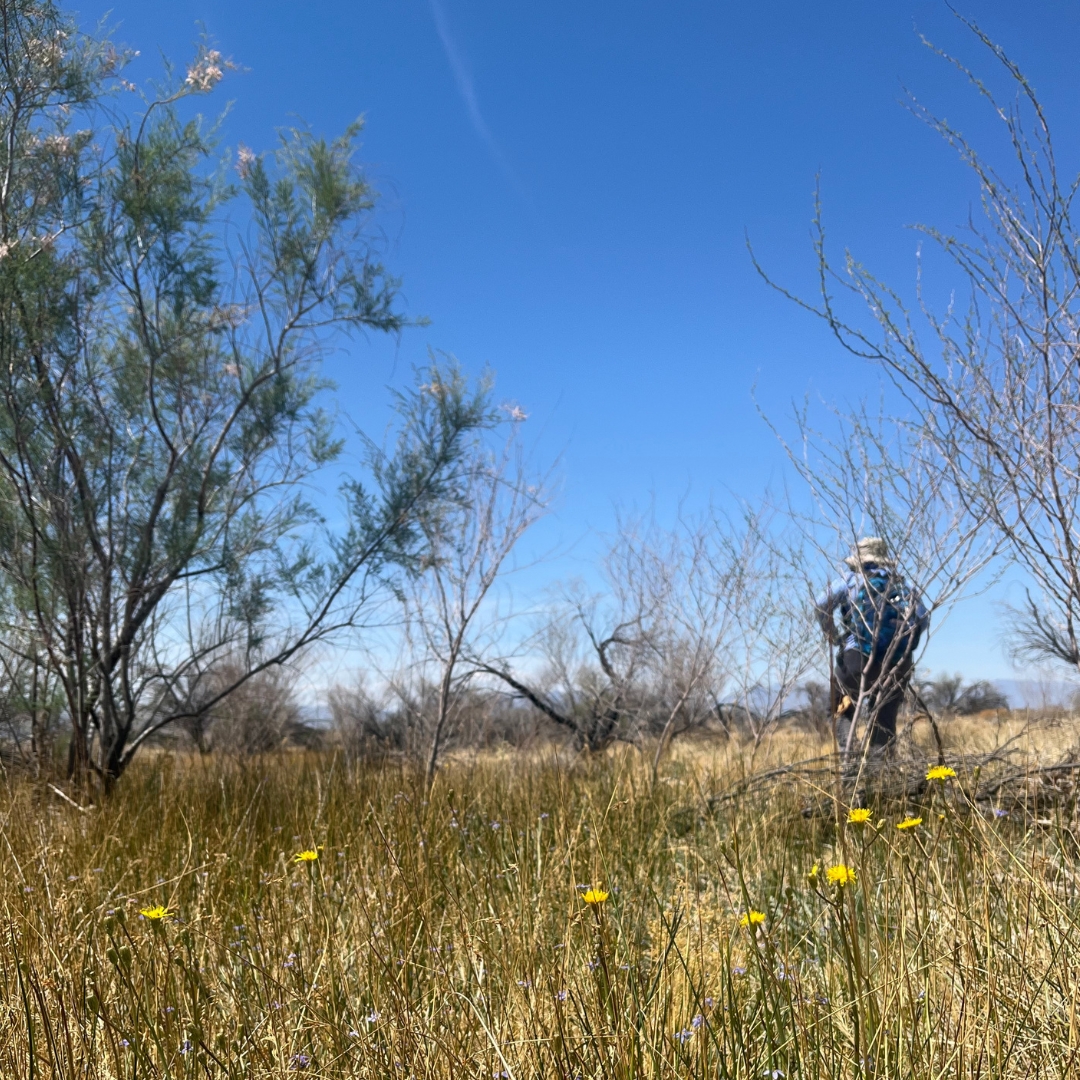
A meadow on BLM land North of Ash Meadows National Wildlife Refuge
We met at the Ash Meadows National Wildlife Refuge visitor center at 8 a.m, the full sun already on us, before heading out to BLM NV land north of the Refuge. One of our target species was the Tecopa Bird’s Beak (Chloropyron tecopense), an annual plant listed as a BLM sensitive species. As we drove down the dusty gravel road, we scanned for its preferred habitat– where springs surface and enough water flows to turn the cracked, saline sand into muddy puddles and ephemeral streams. If you’re just driving by, you’d be forgiven for passing water without realizing it. In the desert, water is often hidden and green– cattails bursting from springs, dense clusters of bent mesquites, algae stretching across streams only a few inches deep. For these alkaline wetland plants, you also have to have a sharp eye for soil texture– salt crusts with just a hint of bronze or copper mud indicates groundwater beneath.
A Western Meadowlark sang its whistle-warble song from a mesquite as we scouted our first wetland, Naomi and her students kneeling and taking pictures of tall, stalky Mojave Thistle (Cirsium mohavense) and golden-flowered Fiddleleaf Hawksbeard (Crepis runcinata). They conversed in Latin, or so it seemed, with the scientific plant names used instead of common names in the field– there are just too many variations of common names. The Mojave Thistle, for example, can also be called virgin thistle, and the Fiddlelaf Hawksbeard can be called meadow hawksbeard.
In clumps of tangled saltgrass, we found the dry “skeletons” of Tecopa Bird’s Beak from last year’s growth. Like other annuals, they die off after producing their seeds. That means most of their life is spent underground, waiting for the right conditions to germinate and grow. Their pale remains were both a memory and prediction, for we know that the Tecopa Bird’s Beak is waiting under our feet and will emerge from these wetlands in a few months, prompted by the heat. That’s why we do these surveys so early in the spring, to establish a baseline from year to year of each population.
About halfway through the day, we found some flowering Blue Eyed-Grass, plants in the Iris family that grow little violet-blue flowers. Out in the Amargosa River Basin, there are a few species of Blue-eyed Grass, two notable ones are Sisyrinchium funereum and its close look alike Sisyrinchium radicatum. Because they look so similar, Naomi had one sample dug out and pressed for the herbarium collection for further identification. After the botanists analyzed the plant specimen at CalBG, its identity was confirmed: Sisyrinchium radicatum. Had we not collected a sample, it may have been overlooked or misidentified. In the yellow center of one flower, I found a tiny native bee, smaller than my pinky nail, reminding me of the undiscovered biodiversity on the landscape’s micro-scale.
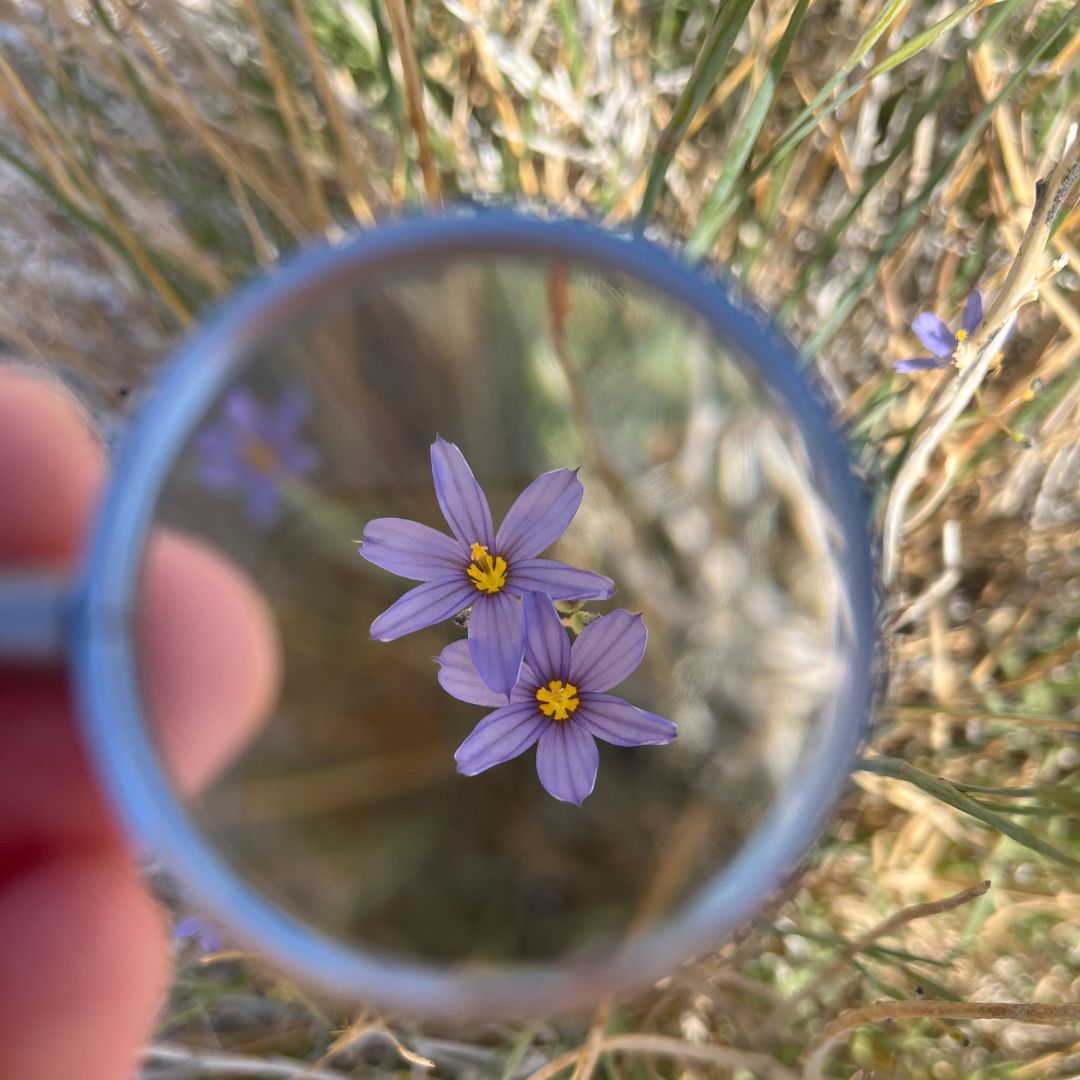
A close look at Sisyrinchium radicatum
No plant embodies the Amargosa River Basin’s mysterious micro-universes better than the Amargosa Niterwort (Nitrophila mohavensis), a rare and endangered plant found nowhere else in the world than a few pockets around Ash Meadows and Tecopa. The Amargosa Niterwort likes to grow in salt flats with no other vegetation– areas that, unless you’re looking as a botanist, you might write off as bright and barren.
But there are surprises even here. On our second day of monitoring, we scouted for niterwort around the Tecopa Hot Springs, crossing invisible boundaries of parcels owned by private businesses, California Department of Fish & Wildlife, and the BLM. We spread out and criss-crossed over the pock-marked salt mounds, checking in on one known niterwort population that was just beginning to sprout for the year. Some even had tiny pink flowers, which perhaps, though we don’t know for sure, are beacons to ants to come and pollinate.
We headed south, finding a lone niterwort growing on a hillside, and continued until, about forty feet away, Naomi spotted more. Much to our delight, this population had never been documented, and was the first time Amargosa Niterwort has been recorded as growing on a hillside. There is always a chance of new discovery out here among the salt.
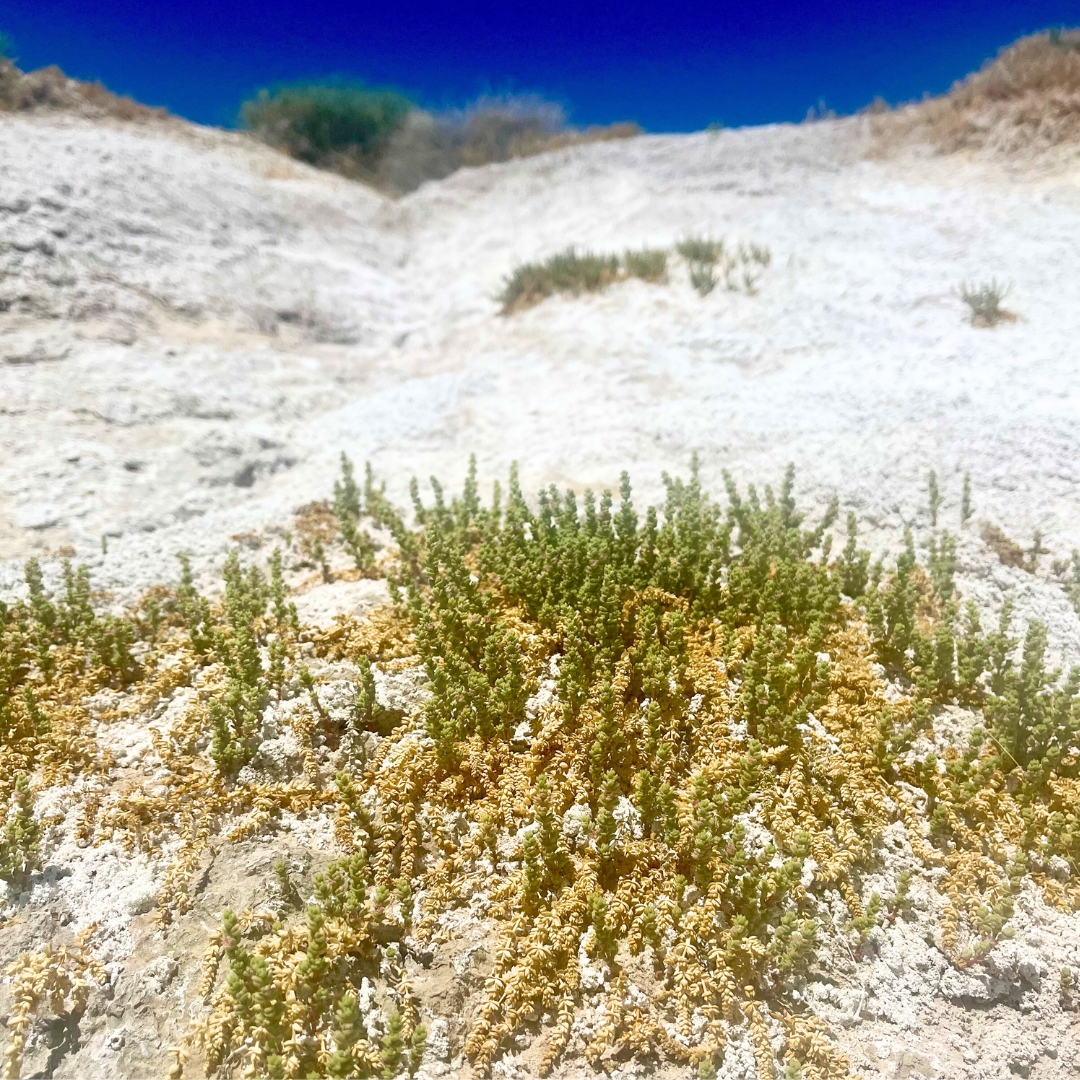
Southernmost documented Amargosa Niterwort population
The heat and remoteness of the Amargosa invites you to slow down, to look closer, then to look even closer. As a birder, I have a tendency to look at plants as habitat, to see compositions of plants, rather than individuals. I think about the shelter they create, the food they provide: seeds, fruit, fresh growth that other animals eat. And while assessing habitats and seeing interrelationships between organisms is necessary for conservation, it’s not the only lens. For Naomi and her students, their love is rooted in the plants for the plants’ sake. They want to document the phylogenetic structure, or the evolutionary family tree, of these plants because the plants have a story to tell in their own right– not as a backdrop to other organisms. They want to know their genetic structure and the taxonomy of relationships between species, all to paint a fuller picture of how these plant populations ended up, in this vast world, exactly where they are today.
We discussed this as we scouted across the alkaline wetlands of the ancient Lake Tecopa, which was once a large, saline lake fed by the Amargosa River that covered the towns of Tecopa and Shoshone in the pleistocene, roughly 7-11 million years ago. Naomi wondered aloud about how the Tecopa Bird’s Beak populations have spread across the Amargosa River Basin. Were they dispersed by massive floods? Did they get genetically isolated as Lake Tecopa dried up? We don’t know for certain, but as we discover more populations and collect more tissue samples for genetic analysis, we come closer.
The saltgrass (Distichlis spicata), is a ubiquitous plant in these alkaline wetlands, one that is necessary for stabilizing soils. As we marched through the dried lakebed, Horned Larks, small songbirds that eat seeds and insects, chipped and dashed away from us, leading me to more swathes of saltgrass, which at first, I thought all looked the same. Fortunately, I was shown otherwise, and another world opened its petals to me. A few individuals were showing their anthers, the “male part” of the plant– tiny, pale-gold bulbs that produce pollen. The saltgrass grows as separate male and female individuals, reproducing sexually and signaling that the season is changing on a scale I would have otherwise overlooked. And when I step through more and more stretches of saltgrass, I notice some have little salt halos, rings around their blades from when they pushed through the salt crust to sprout. Salt that was, millions of years ago, underwater.
I’ve got a long way to go before I see the landscape with a true botanist’s eyes. But we’ll be back out in June and July, waking up before sunrise to gather seeds from the rare and endangered plants in the Amargosa River Basin, becoming one with the heat that sustains these alkaline wetlands.
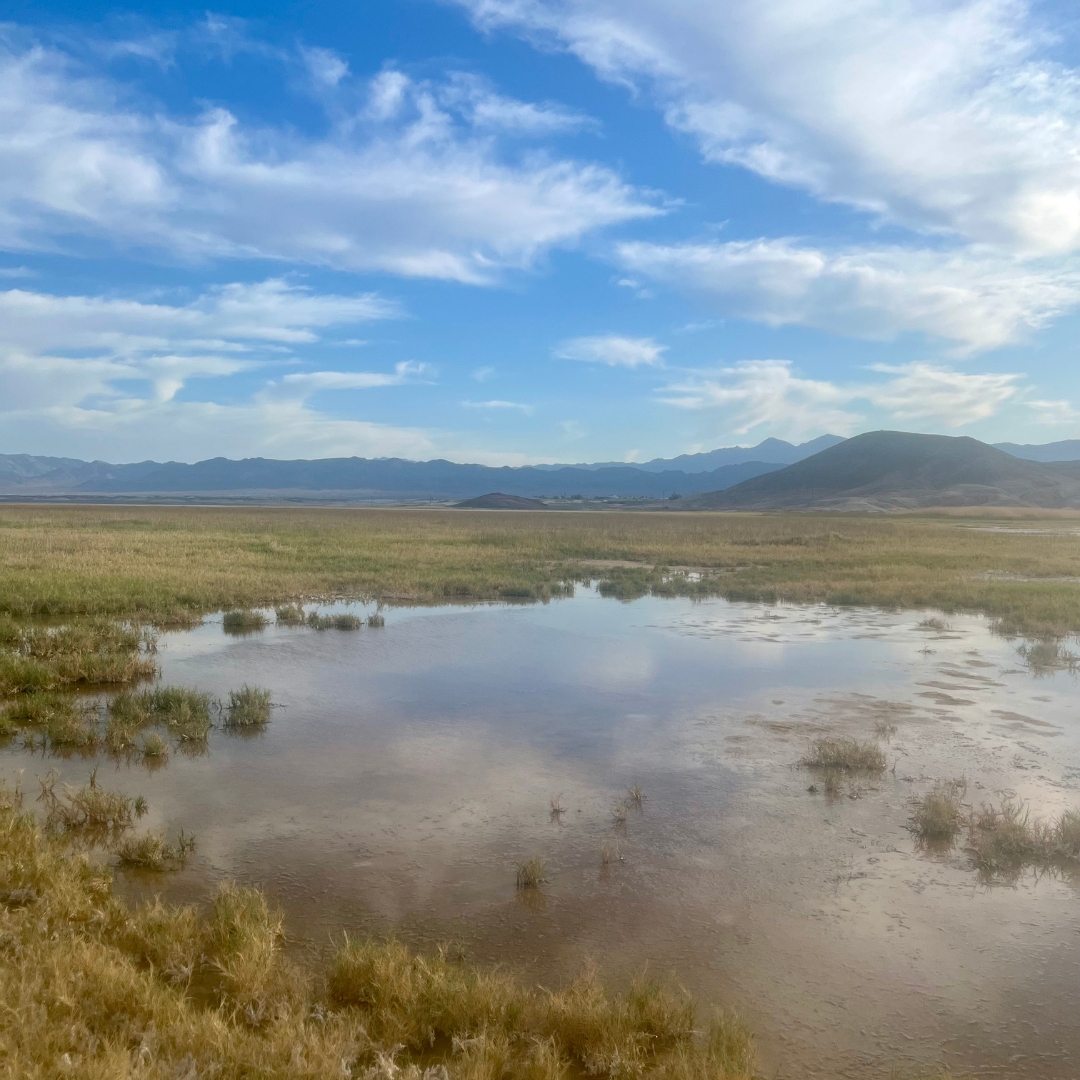
A view of the saltgrass meadows near Tecopa
